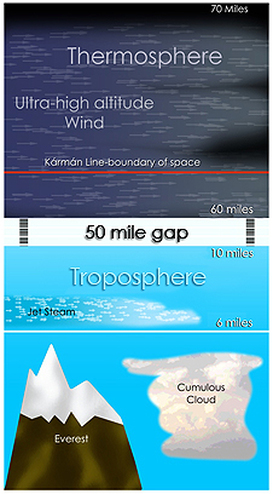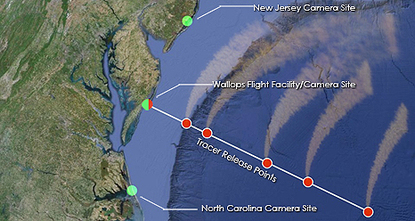On Friday 23 March 2012, between midnight and 3 a.m., NASA will launch five 'sounding rockets' in approximately five minutes to measure 200-300 mile-per-hour winds at the edge of space. This mission will trace these winds and study their intimate connection to the complicated electrical current patterns that surround Earth. NASA/Goddard Space Flight Center High in the sky, 60 to 65 miles above Earth's surface, winds rush through a little understood region of Earth's atmosphere at speeds of 200 to 300 miles per hour. Lower than a typical satellite's orbit, higher than where most planes fly, this upper atmosphere jet stream makes a perfect target for a particular kind of scientific experiment: the sounding rocket. Some 35 to 40 feet long, sounding rockets shoot up into the sky for short journeys of eight to ten minutes, allowing scientists to probe difficult-to-reach layers of the atmosphere. On 23 March, NASA will launch five such rockets in approximately five minutes to study these high-altitude winds and their intimate connection to the complicated electrical current patterns that surround Earth. First noticed in the 1960s, the winds in this jet stream shouldn't be confused with the lower jet stream located around 30,000 feet, through which passenger jets fly and which is reported in weather forecasts. This rocket experiment is designed to gain a better understanding of the high-altitude winds and help scientists better model the electromagnetic regions of space that can damage man-made satellites and disrupt communications systems. The experiment will also help explain how the effects of atmospheric disturbances in one part of the globe can be transported to other parts of the globe in a mere day or two. |
"This area shows winds much larger than expected," says Miguel Larsen, a space scientist at Clemson University who is the principal investigator for these five rockets, known as the Anomalous Transport Rocket Experiment (ATREX). "We don't yet know what we're going to see, but there is definitely something unusual going on. ATREX will help us understand the big question about what is driving these fast winds." |
The rockets will be launched on a clear night within a period of minutes, so the trails can all be seen at the same time. The trimethyl aluminum will then be released in space out over the Atlantic Ocean at altitudes from 50 to 90 miles. The cloud tracers will last for up to 20 minutes and will be visible in the mid-Atlantic region, and along the east coast of the United States from parts of South Carolina to New Jersey.
You can read the rest of the story, with short video, here: http://www.nasa.gov/mission_pages/sunearth/missions/atrex-nightlight.html
To try to spot the sounding rocket trails, follow the launch status updates at: http://www.nasa.gov/mission_pages/sunearth/missions/atrex.html


 RSS Feed
RSS Feed